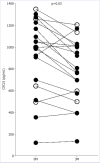Serum CXCL5 as a biomarker in multiple sclerosis and neuromyelitis optica spectrum disorder
- PMID: 37435281
- PMCID: PMC10331241
- DOI: 10.14744/nci.2022.77861
Serum CXCL5 as a biomarker in multiple sclerosis and neuromyelitis optica spectrum disorder
Abstract
Objective: Our aim was to determine whether serum C-X-C motif chemokine 5 (CXCL5) may serve as a diagnostic biomarker for relapsing-remitting multiple sclerosis (RRMS) as well as a marker that can be used to predict treatment response.
Methods: CXCL5 levels were measured by ELISA in sera of 20 RRMS patients under fingolimod treatment, 10 neuromyelitis optica spectrum disorder (NMOSD) patients, 15 RRMS patients presenting predominantly with spinal cord and optic nerve attacks (MS-SCON), and 14 healthy controls.
Results: Fingolimod treatment significantly reduced CXCL5 levels. CXCL5 levels were comparable among NMOSD and MS-SCON patients.
Conclusion: Fingolimod might regulate the innate immune system. Serum CXCL5 measurement does not differentiate between RRMS and NMOSD.
Keywords: C-X-C motif chemokine 5; fingolimod; multiple sclerosis; neuromyelitis optica spectrum disorder.
© Copyright 2023 by Istanbul Provincial Directorate of Health.
Conflict of interest statement
No conflict of interest was declared by the authors.
Figures


Similar articles
-
Chloride intracellular channel protein-1 (CLIC1) antibody in multiple sclerosis patients with predominant optic nerve and spinal cord involvement.Mult Scler Relat Disord. 2023 Oct;78:104940. doi: 10.1016/j.msard.2023.104940. Epub 2023 Aug 13. Mult Scler Relat Disord. 2023. PMID: 37603930
-
Case Report: Severe rebound after withdrawal of fingolimod in a patient with neuromyelitis optica spectrum disorder.Front Immunol. 2023 Apr 14;14:1115120. doi: 10.3389/fimmu.2023.1115120. eCollection 2023. Front Immunol. 2023. PMID: 37122715 Free PMC article.
-
Is Fertility Affected in Women of Childbearing Age with Multiple Sclerosis or Neuromyelitis Optica Spectrum Disorder?J Mol Neurosci. 2020 Nov;70(11):1829-1835. doi: 10.1007/s12031-020-01576-x. Epub 2020 Aug 1. J Mol Neurosci. 2020. PMID: 32740781
-
Glial fibrillary acidic protein as a biomarker in neuromyelitis optica spectrum disorder: a current review.Expert Rev Clin Immunol. 2023 Jan;19(1):71-91. doi: 10.1080/1744666X.2023.2148657. Epub 2022 Nov 30. Expert Rev Clin Immunol. 2023. PMID: 36378751 Review.
-
Spinal cord atrophy in neuromyelitis optica spectrum disorders.Mult Scler Relat Disord. 2016 Jul;8:9-10. doi: 10.1016/j.msard.2016.04.007. Epub 2016 Apr 19. Mult Scler Relat Disord. 2016. PMID: 27456868 Review.
Cited by
-
Soluble biomarkers for Neuromyelitis Optica Spectrum Disorders: a mini review.Front Neurol. 2024 May 16;15:1415535. doi: 10.3389/fneur.2024.1415535. eCollection 2024. Front Neurol. 2024. PMID: 38817544 Free PMC article. Review.
References
-
- Kostic M, Dzopalic T, Zivanovic S, Zivkovic N, Cvetanovic A, Stojanovic I, et al. IL-17 and glutamate excitotoxicity in the pathogenesis of multiple sclerosis. Scand J Immunol. 2014;79:181–6. - PubMed
-
- Chang MS, McNinch J, Basu R, Simonet S. Cloning and characterization of the human neutrophil-activating peptide (ENA-78) gene. J Biol Chem. 1994;269:25277–82. - PubMed
-
- Sheridan GK, Dev KK. S1P1 receptor subtype inhibits demyelination and regulates chemokine release in cerebellar slice cultures. Glia. 2012;60:382–92. - PubMed
LinkOut - more resources
Full Text Sources
